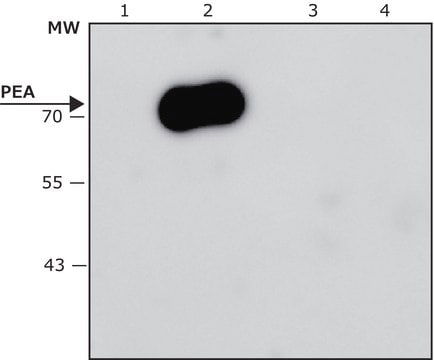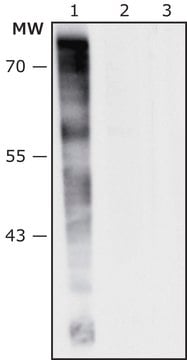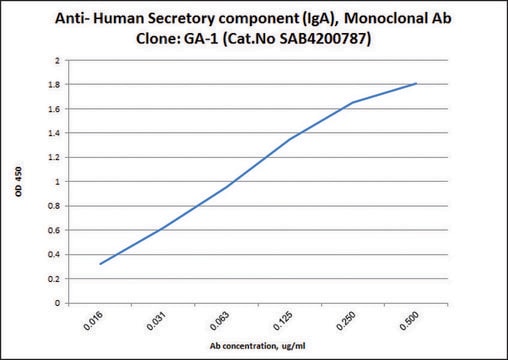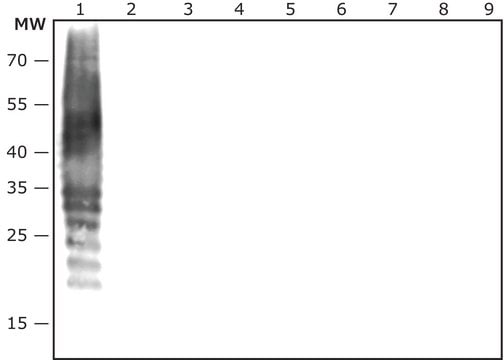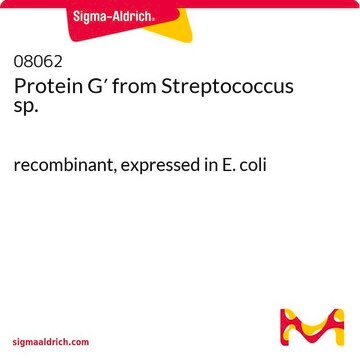SAB4200868
Anti-Enterococcus faecalis antibody produced in rabbit
IgG fraction of antiserum
Iniciar sesiónpara Ver la Fijación de precios por contrato y de la organización
About This Item
Código UNSPSC:
12352203
NACRES:
NA.43
Productos recomendados
Nivel de calidad
formulario
liquid
reactividad de especies
(Enterococcus faecalis)
concentración
~1 mg/mL
Condiciones de envío
dry ice
temp. de almacenamiento
−20°C
modificación del objetivo postraduccional
unmodified
Descripción general
Enterococcus faecalis is a gram positive, non-motile, facultative anaerobic, coci-shaped bacterium.1,2 It is a commensal bacterium of the human gut and a major opportunistic pathogen in susceptible hosts.1 E. faecalis is the third most common pathogen associated with hospital-acquired infections.2 E. faecalis inhabits the gut in 80% of healthy adultsand is also a part of the oral cavity normal flora in 20% of the adult population. In addition, E. faecalis was also identified in the human urinary tract.1
Especificidad
Anti-Enterococcus faecalis antibody recognizes E. faecalis lysate and whole dead bacteria
Aplicación
The antibody may be used in various immunochemical techniques including Immunoblotting. Detection of the E. faecalis bands by Immunoblotting is specifically inhibited by the immunogen.
Acciones bioquímicas o fisiológicas
E. faecalis contributes to the host in several ways, such as, competing with pathogen bacteria and preventing them from reaching the gut epithelia, prevention of intestinal epithelial barrier leakage and provision of protection from pathogens to the young infant through breast milk consumption.1,3-5
Moreover, E. faecalis also has many effects on the immune system that are beneficial to the host, such as, promoting the secretion of anti-inflammatory cytokines IL-10 and TGF-ß and induction of IgA production.1,6,7
However, when the homeostasis in the gut and mucus barrier is disrupted, especially in susceptible individuals such as in inflammatory bowel diseases (IBD) patients, or upon antibiotic administration, E. faecalis might become an opportunistic pathogen. In such case, the bacteria population overgrows and translocates through the mucus barrier to reach the epithelial cells of the gut where it can enter the bloodstream and the lymphatic system and cause severe inflammation.
Moreover, E. faecalis also has many effects on the immune system that are beneficial to the host, such as, promoting the secretion of anti-inflammatory cytokines IL-10 and TGF-ß and induction of IgA production.1,6,7
However, when the homeostasis in the gut and mucus barrier is disrupted, especially in susceptible individuals such as in inflammatory bowel diseases (IBD) patients, or upon antibiotic administration, E. faecalis might become an opportunistic pathogen. In such case, the bacteria population overgrows and translocates through the mucus barrier to reach the epithelial cells of the gut where it can enter the bloodstream and the lymphatic system and cause severe inflammation.
Forma física
Supplied as a solution in 0.01 M phosphate buffered saline pH 7.4, containing 15 mM sodium azide as a preservative.
Almacenamiento y estabilidad
For continuous use, store at 2-8°C for up to one month. For extended storage, freeze in working aliquots. Repeated freezing and thawing is not recommended. If slight turbidity occurs upon prolonged storage, clarify the solution by centrifugation before use. Working dilution samples should be discarded if not used within 12 hours.
Cláusula de descargo de responsabilidad
Unless otherwise stated in our catalog our products are intended for research use only and are not to be used for any other purpose, which includes but is not limited to, unauthorized commercial uses, in vitro diagnostic uses, ex vivo or in vivo therapeutic uses or any type of consumption or application to humans or animals.
Código de clase de almacenamiento
12 - Non Combustible Liquids
Clase de riesgo para el agua (WGK)
nwg
Punto de inflamabilidad (°F)
Not applicable
Punto de inflamabilidad (°C)
Not applicable
Certificados de análisis (COA)
Busque Certificados de análisis (COA) introduciendo el número de lote del producto. Los números de lote se encuentran en la etiqueta del producto después de las palabras «Lot» o «Batch»
¿Ya tiene este producto?
Encuentre la documentación para los productos que ha comprado recientemente en la Biblioteca de documentos.
Nuestro equipo de científicos tiene experiencia en todas las áreas de investigación: Ciencias de la vida, Ciencia de los materiales, Síntesis química, Cromatografía, Analítica y muchas otras.
Póngase en contacto con el Servicio técnico
